Francesco Guardi (Venice, 1712 - 1793), a Venetian born into a family of Trentino origin who moved to the lagoon, was one of the greatest vedutisti and one of the most important painters of the 18th century. Although he came late to paint the views that made him famous, his is a highly original art, in that the landscape is not rendered objectively, but is filtered through his feeling and mood. Guardi was the author of works of art characterized by elusive, nostalgic and melancholy atmospheres, from which the decline of the Venetian Republic is perceived, but also very suggestive and evocative, so much so that some consider him a forerunner of Romanticism.
The artist disappeared in 1793, a few years before the end of the independence of the Venetian Republic in 1797. So, like Canaletto, Francesco Guardi also experienced the slow and unstoppable decline of the Serenissima, which continued, throughout the 18th century, not only to lose its territories, but also to lose more and more economic and political importance, as the Republic had also renounced policies of expansion but settled for a policy of preservation. But even if the loss of prestige was unstoppable, Venice nevertheless experienced a great cultural season in this epoch, not only in the figurative arts, and there were indeed many great Venetian painters who worked in these years, but also in other fields: think for example of music, with Antonio Vivaldi, or of literature with Giacomo Casanova, Francesco Algarotti, Carlo Gozzi but above all with Carlo Goldoni. Eighteenth-century Venice is thus characterized by great cultural fervor: life in the city flowed between great festivals, worldliness and entertainment. Moreover, throughout the eighteenth century, Venice continued to attract many foreign visitors. A city going through a period of decadence that would later lead to the end of the republic’s independence, but a city that hardly seemed to notice all this and continued to live as in its best years, in a brilliant and refined cultural atmosphere.
With his art, Francesco Guardi, who was not born as a vedutista painter (although we know very little about his youth and early training), but came to know art thanks to his brother Gianantonio (Vienna, 1699 - Venice, 1760) who specialized in paintings of religious subjects, nevertheless managed through his foreshortenings to portray the decaying Venice with a vein of deep melancholy, as if the artist was sensing what was soon to come.
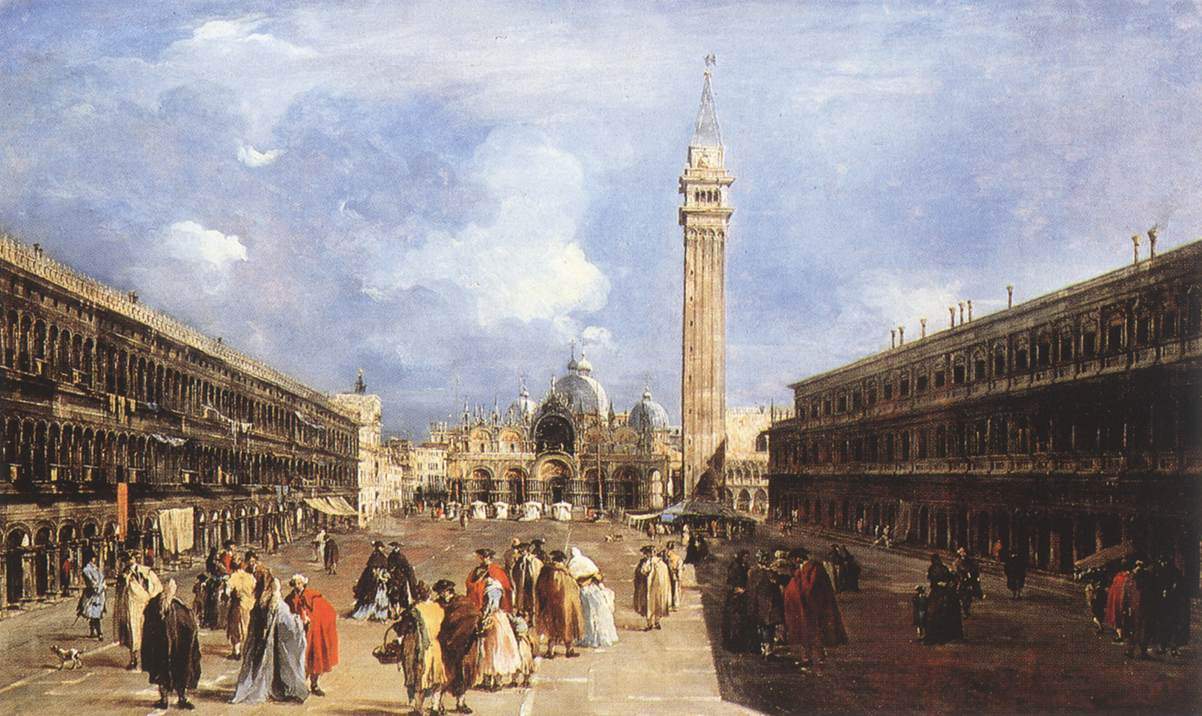 |
| Francesco Guardi, Piazza San Marco towards the Basilica (1760-1765; oil on canvas, 72.5 x 119 cm; London, National Gallery) |
Francesco Guardi was born in Venice on October 5, 1712, to Domenico, a painter, and Maria Claudia Pichler. The family is of Trentino origin and relies on a solid artistic tradition. In the 1730s he performed his artistic apprenticeship in the workshop of his brother Gianantonio. He was probably also a pupil of Michele Marieschi (Venice, 1710 - 1744) but we cannot establish this with certainty. In 1738 he is mentioned together with Gianantonio in a document that mentions the delivery of three paintings arriving from Venice to the church of Vigo d’Anaunia (Trento), whose parish priest was Pietro Antonio Guardi, uncle of Gianantonio and Francesco. In 1740 he executed his first known work, the Saint in Adoration of the Eucharist preserved in Trento in the Castello del Buonconsiglio. Dated 1750 are a number of letters sent to the lawyer Carlo Cordellina of Montecchio Maggiore, which constitute the first document related to his independent artistic activity. About the same year Francesco executed the Stories of Tobiolo for the church of San Raffaele in Venice.
In 1755 he painted the Ridotto preserved in Venice at Ca’ Rezzonico, while in 1757 he married Maria Mattea Pagani. Perhaps around 1758, at the age of forty-six, he began his activity as a vedutista painter. His only view signed and dated moreover bears the date 1758. In 1763 he was given a commission by the Dominicans of San Pietro di Murano, while the following year he is mentioned in a document drafted by the Venetian senator Pietro Gradenigo, who mentions him as a “good pupil of the renowned Canaletto,” although this does not necessarily mean that Francesco frequented Antonio Canal’s workshop. Around 1765 he executed the Veduta del Canal Grande verso Rialto , preserved at the Pinacoteca di Brera. In 1768, Canaletto disappeared and Francesco became the most fashionable vedutista painter in Venice.
Around 1770, Francesco Guardi painted the Lagoon of Venice with the Tower of Marghera at the National Gallery in London. Around the same year he executed the Capriccio preserved at the Accademia Carrara in Bergamo. In 1778 he made a sojourn in Trentino, his family’s homeland, while in 1782 he was commissioned to paint some paintings depicting the reception in Venice of the Crown Prince of Russia. In contrast, his last official assignment dates back to 1790: Francis was to execute paintings depicting the wedding between the Duke of Polignac and the Baroness of Neukirchen. The artist died in Venice on January 1, 1793.
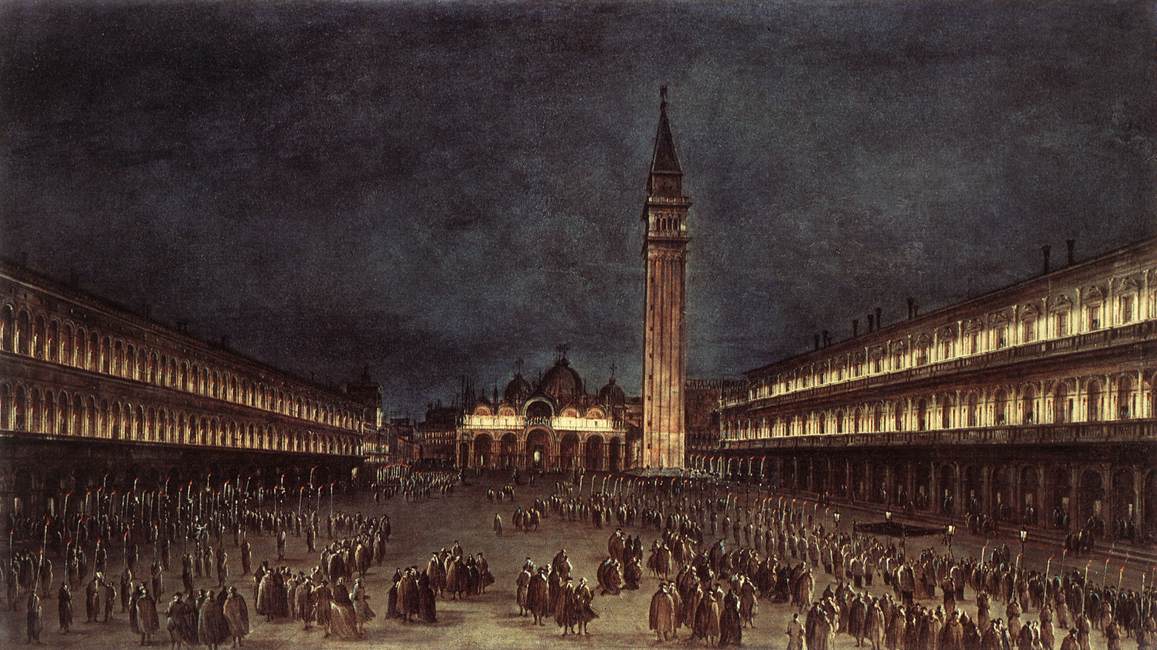 |
| Francesco Guardi, Night Procession in St. Mark’s Square (1758; oil on canvas, 48 x 85 cm; Oxford, Ashmolean Museum) |
 |
| Francesco Guardi, The Piazzetta towards San Giorgio Maggiore (1758; oil on canvas, 49 x 83.5 cm; Treviso, Museo Civico) |
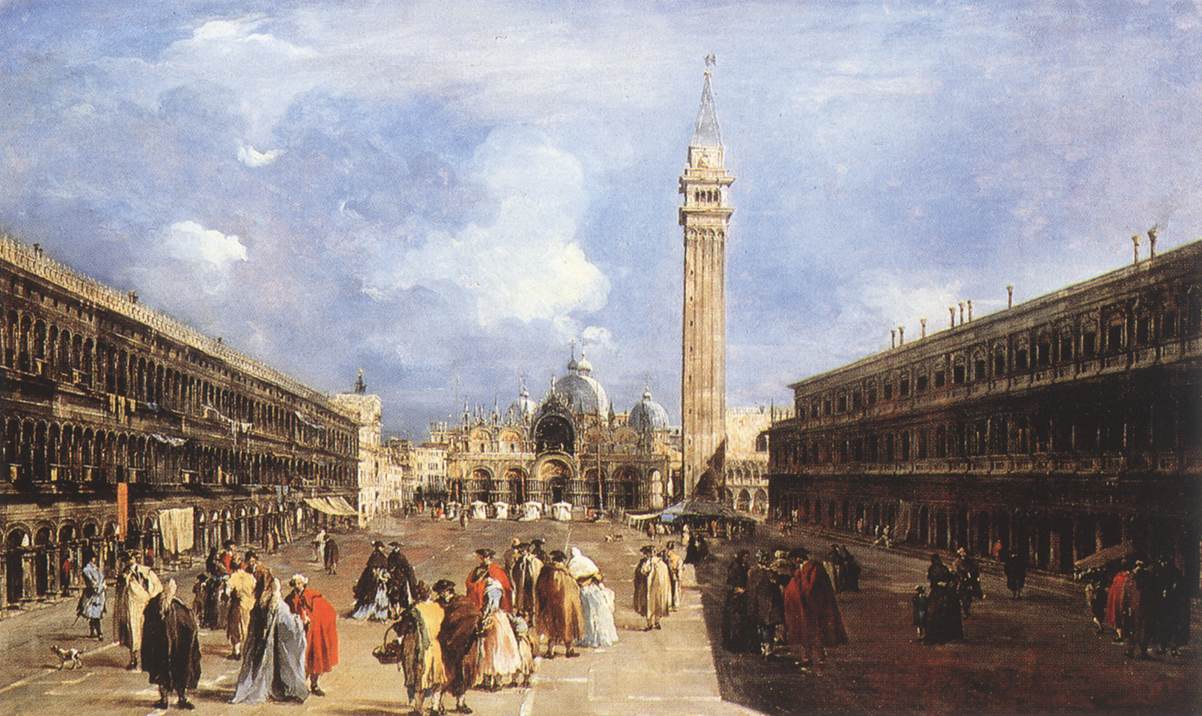 |
| Francesco Guardi, The Grand Canal toward the Rialto Bridge (c. 1765; oil on canvas, 56 x 75 cm; Milan, Pinacoteca di Brera) |
It is difficult to understand how Francesco Guardi came to vedutismo: we do not know the exact date of his conversion, although it is possible that his contacts with this movement were early, as some scholars think that he was already a pupil of Michele Marieschi as early as 1735. However, it is also likely, as many argue, that his Vedutist turn only followed the death of his brother in 1760. Still, it can be assumed that his beginnings as a vedutista date to the mid-1750s, when Venice experienced a new and massive influx of English tourists, initiated following the end of the first war of the Austrian succession, which had partially interrupted foreign tourism in the city during the 1940s, and moreover this was also one of the reasons that drove Canaletto to England, since he could no longer get clients at home. An interesting document from 1764 is also preserved, from which we learn that a Venetian nobleman, Pietro Gradenigo, describes Francesco Guardi in one of his diaries as a “good pupil of the renowned Canaletto.” This, however, does not mean, therefore, that Francesco Guardi was a pupil of Canaletto: one should not take literally the term “schoolboy,” which at the time had a broader meaning than it does today (in this context it simply means that, at the beginning of his career as a vedutista, Francesco Guardi could only look to the highest model, namely the art of Canaletto).
In Francesco Guardi’s early vedutista production (e.g., the view of the church of San Giorgio Maggiore preserved in the Museo Civico in Treviso, or the night procession in St. Mark’s Square preserved in Oxford) there is a tangible resemblance to the art of Canaletto, which can be seen in the way the artist makes use of perspective, the great precision with which the architecture is described and which could only recall the art of Canaletto, and also in the way the figures are arranged. Another famous and also very beautiful and striking painting is the Night Procession in St. Mark’s Square, which is located in Oxford. However, as early as the second half of the 1960s, Francesco Guardi began to elaborate a very personal vedutismo, in effect beginning to create the artworks that made his work unique and original, which thus became increasingly distant from Canaletto’s art. Beginning in this era, Francesco Guardi will paint vedut filtered not only by his eye, but above all by his feeling: these will be works of intense and at the same time somber lyricism, because the paintings begin to become elusive, to evoke the atmosphere of decadence of the Republic of Venice, the decline of the Serenissima. Francesco Guardi’s Venice is thus an interior Venice, a perceived Venice, for while it is true that life in the city, despite the republic’s loss of prestige, continued amid festivities and worldliness, the painter nonetheless returns many works from which there is a sense of nostalgia, painted through the sensations and impressions of the artist, who proves to be exceedingly sensitive.
Among Francesco Guardi’s most important and famous works are two views of the Grand Canal that date from 1765 and are located in Milan, at the Pinacoteca di Brera: here, the precision of the architecture of his earlier years begins to give way to buildings whose perspective is less rigorous than that of his production that was inspired by Canaletto, opening the field to the sentimentalism that would later characterize the later production of his career. With the paintings of the 1970s, the poignant, nostalgic, lyrical and even almost dreamlike component of Francesco Guardi’s production comes decisively out into the open, and to notice this it is enough to look at one of his most famous paintings, namely the view of the basin of San Marco with the island of San Giorgio Maggiore, which dates from the early 1970s and is preserved at the Gallerie dell’Accademia in Venice. It is also interesting because the painter would later return several times to this subject, which was one of his favorites. The painting is characterized by dark tones, with the sky seeming almost to blend with the water for a result of dense lyricism, so much so that several scholars argue that Francesco Guardi’s is a sensibility that anticipates a Romanticism, precisely by virtue of the fact that by now the landscape he depicts on the canvas is no longer what he sees with his eyes, but is what he feels. Francesco Guardi’s veduta is an individual and subjective affair, linked to his state of mind that he was sensing the decline of the Venetian republic, and to emphasize this his chromatic range also shrinks quite a bit, his brushstrokes becoming dry and rather nervous, as is the case, for example, in a painting from the second half of the 1970s, namely the Molo verso Santa Maria della Salute preserved at the Franchetti Gallery at the Ca’ d’Oro in Venice, where the deliberately insecure perspective foreshortening that characterizes much of this production by Francesco Guardi still returns then. Mention should also be made of a beautiful painting in the National Gallery in London, a view of the Venice lagoon with the tower of Marghera in the background, marked by a melancholy, poignant atmosphere, with two solitary boats immersed in nature. The real protagonists of this painting are the sky and the sea, with the ruined tower (it was demolished in the early 19th century), which serves to emphasize the melancholy of what looks almost like a romantic landscape. The same atmosphere is evoked by two paintings with the same subject, namely the gondola on the lagoon, one at the National Gallery and one at the Poldi Pezzoli in Milan, which can be dated to the 1980s. In particular, the Milan painting is a great masterpiece, melancholy, with a reduced color palette based on gray and light blue, where the sky at sunset is just slightly lighter than the sea and blends with the sea, a calm sea, inspiring silence and calm since the city is far away, a sea ploughed only by a gondola in the foreground, driven by a single gondolier.
Francesco Guardi’s pre-Romantic soul also emerges from his capricci, or fantasy views: in a painting preserved at the Carrara Academy in Bergamo, a Capriccio with a triumphal arch and human figures, from about 1770, we observe modern ruins (the triumphal arch depicted has a Renaissance layout, although the ogival arch reminds us of Gothic art), with weeds growing and taking over the crumbling buildings, is probably dense with symbolic meanings, as if the painter wants to say that time past can never return. Even with whimsy, then, Guardi communicates a sense of tangible decay. Francesco Guardi is, in short, a poet of the landscape, an artist who through the depiction of the landscape seeks to evoke feelings.
 |
| Francesco Guardi, The Pier Toward Santa Maria della Salute (ca. 1775-1780; oil on canvas, 45 x 71 cm; Venice, Franchetti Gallery at Ca’ d’Oro) |
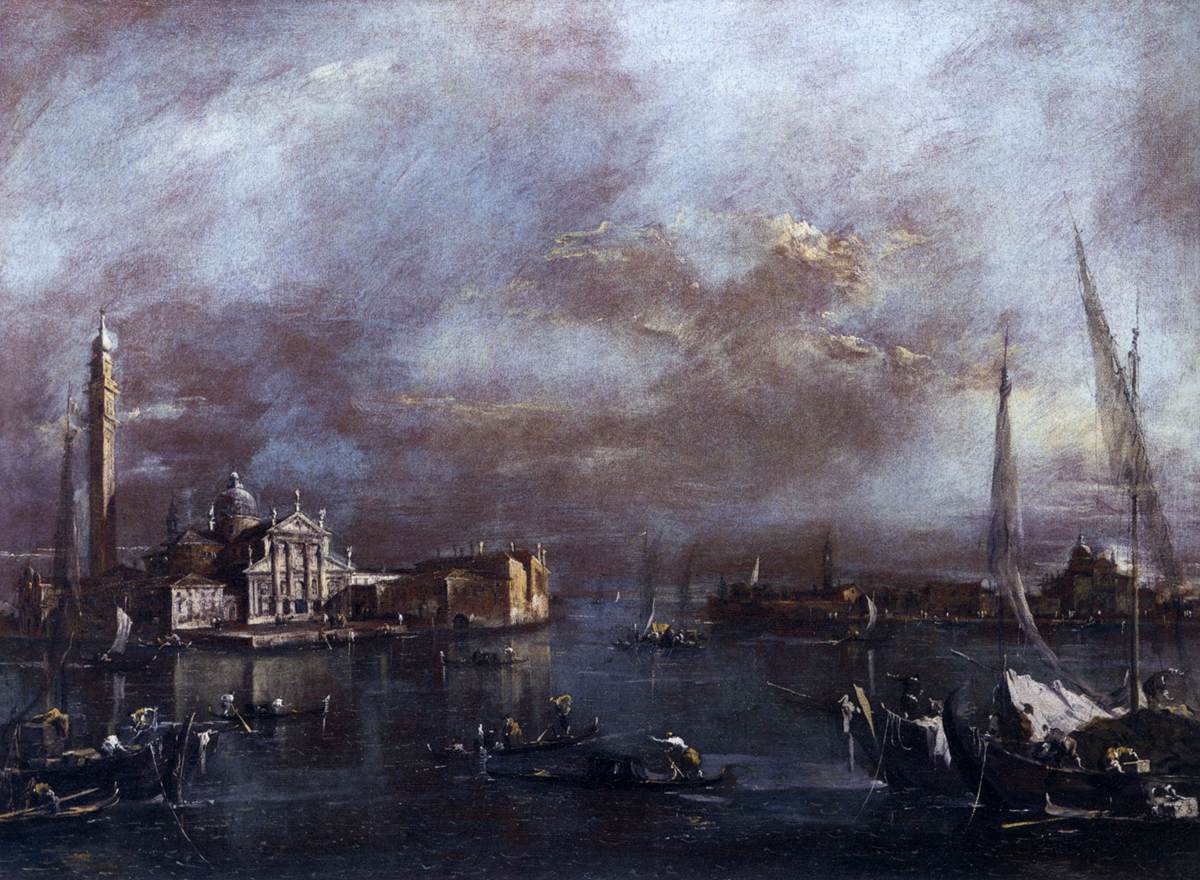 |
| Francesco Guardi, St. Mark’s Basin with St. George and the Giudecca (1770-1774; oil on canvas, 69 x 94 cm; Venice, Gallerie dell’Accademia) |
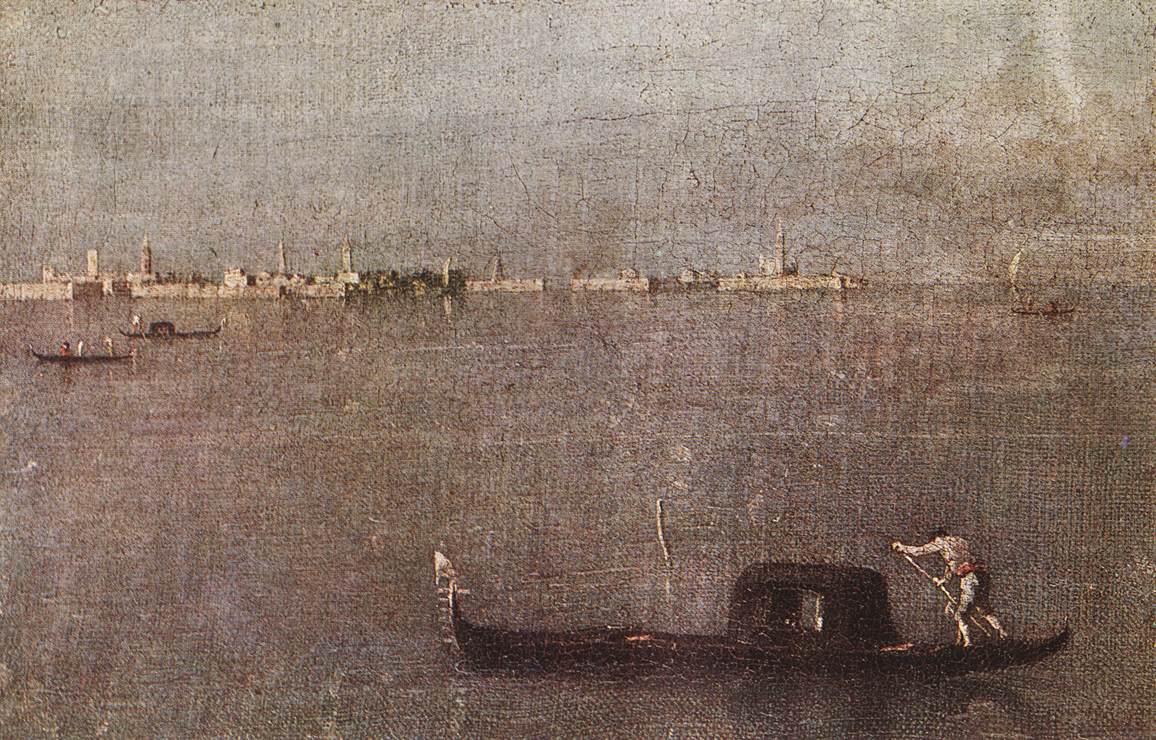 |
| Francesco Guardi, Gondola on the Lagoon (c. 1765; oil on canvas, 31 x 42 cm; Milan, Museo Poldi Pezzoli) |
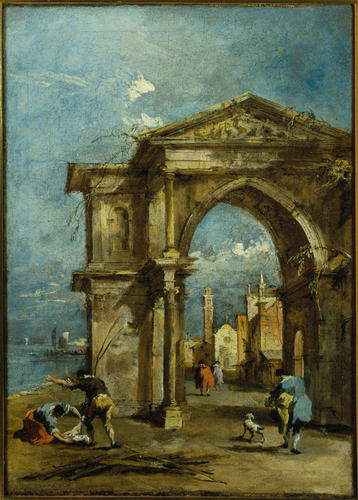 |
| Francesco Guardi, Capriccio with triumphal arch and human figures (c. 1770-1775; oil on canvas, 39 x 26 cm; Bergamo, Accademia Carrara) |
There are hundreds of works by Francesco Guardi, or otherwise referable to the artist. Both early works (e.g., the Stories of Tobiolo, attributed to him, in the Church of the Archangel Raphael) and large, mature views can be seen in Venice (e.g., at the Gallerie dell’Accademia in Venice or the Franchetti Gallery). His important paintings are also preserved in Milan, such as the views at the Pinacoteca di Brera or the Gondola sulla laguna at the Poldi Pezzoli. The Galleria Estense in Modena preserves an important late work, Il bacino di San Marco verso l’isola di San Giorgio, from around 1785, while, on the contrary, to see his early works one has to go to Vigo di Ton, where the lunette with theApparition of the Angel to St. Francis of Assisi in the parish church of Santa Maria Assunta is still to be found.
Outside Italy, it is possible to see works by Francesco Guardi in several museums: in the Louvre, the National Gallery in London, the Museu Calouste Gulbenkian in Lisbon, the Wallace Collection in London, the Hermitage in St. Petersburg, the Akademie der bildenden Künste in Vienna, the Staatliche Museen in Berlin, the National Gallery in Washington, and the Alte Pinakothek in Munich.
 |
| Francesco Guardi, the life and works of the sentimental vedutist |
Warning: the translation into English of the original Italian article was created using automatic tools. We undertake to review all articles, but we do not guarantee the total absence of inaccuracies in the translation due to the program. You can find the original by clicking on the ITA button. If you find any mistake,please contact us.